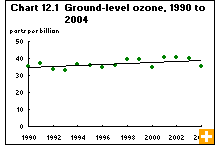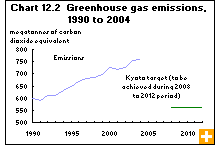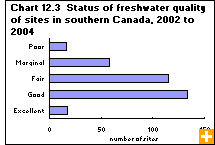Common menu bar links
Environment
Archived Content
Information identified as archived is provided for reference, research or recordkeeping purposes. It is not subject to the Government of Canada Web Standards and has not been altered or updated since it was archived. Please contact us to request a format other than those available.
The 2006 Canadian Environmental Sustainability Indicators—air quality, greenhouse gas (GHG) emissions and freshwater quality—provide evidence of growing pressures on Canada’s environmental sustainability and Canadians’ health and well-being, as well as evidence of potential consequences for our long-term economic performance.
Trends for air quality and GHG emissions point to greater threats to human health and the planet’s climate. The water quality indicator shows that guidelines are being exceeded, at least occasionally, at many selected monitoring sites across the country.
The three indicators provide key information about environmental sustainability, health and well-being, and the consequences of our economic growth and lifestyle choices. Some of the same social and economic forces drive the changes in all three indicators, some of the same substances affect all three and some of the same regions show up as stressed according to all three indicators.
Air quality indicator
Many air pollutants—nitrogen oxides, ground-level ozone, volatile organic compounds (VOCs) and fine particulate matter, to name a few—have adverse effects on the environment and on human health. Smog, for example, is mainly composed of ground-level ozone and fine particulate matter—two pollutants used as national indicators of air quality.
From 1990 to 2004, the ground-level ozone exposure indicator increased an average 0.9% yearly. In 2004, values were highest at monitoring stations in southern Ontario, followed by Quebec and eastern Ontario. Ground-level ozone in southern Ontario has been on an upward trend since 1990. Other regions show no discernable trend.
Produced by human activities, ground-level ozone is formed by chemical reactions involving increases in both nitrogen oxides and VOCs in the presence of sunlight. We contribute to VOCs in the air mainly by producing oil and gas, by driving vehicles, and by burning wood. Most nitrogen oxides come from human actitivies, such as burning fossil fuels.
The highest levels of fine particulate matter for 2004 were primarily in southern Ontario, although some areas in southern Quebec and eastern Ontario also posted high levels.
Exposure to ground-level ozone and fine particulate matter is of concern because there are no established thresholds below which these pollutants are safe. Fine particulate matter especially threatens health because it can travel deep into the lungs. Both these substances can aggravate asthma, emphysema and other respiratory conditions. Children are especially sensitive to the effects of air pollution.
In 2005, 32% of Canadian households were aware of poor air quality advisories in their area. Of those households, 39% made changes to their activity or routine. For example, at least one individual in the household may have used an asthma inhaler, curtailed outdoor physical activity or used public transit instead of their motor vehicle.
Greenhouse gas emissions indicator
Although GHG occurs naturally to help regulate the planet’s climate, human activities result in GHG emissions that contribute to global climate change. In 2004, Canada’s GHG emissions reached 758 megatonnes, 27% higher than in 1990. This rate of increase outpaced population growth, which was 15%. In other words, GHG emissions per person increased 10% over this period—this makes Canada one of the highest per capita GHG emitters in the world.
The geographic distribution of emissions corresponds to the location of natural resources, population and heavy industry—31% of Canada’s GHG emissions came from Alberta in 2004; 27% originated in Ontario.
The rise in GHG emissions from 1990 to 2004 was driven mainly by the oil, gas and coal industries (32% of the overall increase), road transportation (24%) and thermal electricity and heat production (22%).
GHG emissions declined for the chemical, pulp and paper, and construction industries.
Canada’s GHG emissions per unit of gross domestic product fell 14% from 1990 to 2004—more economic activity occurred for each tonne of GHG emitted. A key contributor was efficiency improvements in the energy industry itself, without which total emissions would have been significantly greater. Nonetheless, rapid economic growth has translated into greater GHG emissions.
Water quality indicator
The water quality indicator assesses surface freshwater’s capacity to protect aquatic life such as fish, invertebrates and plants. It does not assess the quality of water for human consumption. To evaluate the potential for adverse effects, experts measure specific substances in water and compare them against scientifically established thresholds.
Primary manufacturers, service industries, institutions and households discharged at least 110,000 metric tonnes of pollutants into Canada’s surface waters in 2004. The largest quantities of pollutants were nitrate ion and ammonia. More highly toxic pollutants, such as mercury, are also released in smaller but still significant amounts. Many pollutants also make their way into water after having been released into the air or onto the land.
Freshwater quality was monitored at 340 selected monitoring sites across southern Canada. It was rated ‘good or excellent’ at 44% of the sites, ‘fair’ at 34% and ‘marginal or poor’ at 22% from 2002 to 2004. At 30 monitoring sites across northern Canada, freshwater quality was rated ‘good or excellent’ at 67% of the sites, ‘fair’ at 20% and ‘marginal or poor’ at 13%.
Water quality in the Great Lakes region is assessed differently from other sites because of the large area of the lakes—about 92,200 square kilometres in Canadian territory—and the nature of the surface water and bottom sediment monitoring program.
In 2004 and 2005, freshwater quality measured in the Great Lakes was rated ‘good or excellent’ for Lake Superior, Lake Huron, Georgian Bay and eastern Lake Erie. For central Lake Erie, it was rated ‘fair,’ while for the western basin of Lake Erie and for Lake Ontario it was ‘marginal.’





